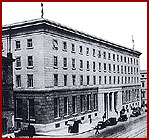
Georgios Kafantaris, Finance minister of the "All-party Government" (Ecumenical Government) that succeeded Pangalos' dictatorship, undertook the task of stabilisation, because apart from securing the guarantee of the League of Nations, he believed that he would restore the country's international credibility. In addition, the balancing of the budget and the stability of the currency would attract foreign capital that would promote Greece's development. Thus, from the summer of 1927 the fiscal reforming, the monetary stability, the foundation of a central bank and the second refugee loan were presented as a unified prerequisite for Greece to come out of the long-standing economic crisis that troubled the country from the beginning of the decade and culminated in the years that followed the Asia Minor disaster.
The stabilisation of the drachma and the foundation of a central bank that would have the exclusivity of the issue privilege, were the conditions set by the League of Nations to the Greek government, in order to guarantee for the contracting of the second refugee loan. G. Kafantaris accepted the conditions of the League of Nations and founded a central bank, although he encountered the reaction of the National Bank, which insisted on maintaining both its capacity as a commercial bank and as regulator of the monetary policy. On September 15, 1927 the minister signed the Geneva Protocol, by virtue of which the League of Nations offered guarantee for a loan of 9,000,000 pounds. Remaining faithful to his obligations Kafantaris announced on May 12, 1928 the stabilisation of the exchange rate at 375 GDR/1 BP. The drachma would circulate freely, with free convertibility into gold by the Bank of Greece, the central issuing bank, which was founded two days later. Its first governor was Alexandros Diomidis. were the conditions set by the League of Nations to the Greek government, in order to guarantee for the contracting of the second refugee loan. G. Kafantaris accepted the conditions of the League of Nations and founded a central bank, although he encountered the reaction of the National Bank, which insisted on maintaining both its capacity as a commercial bank and as regulator of the monetary policy. On September 15, 1927 the minister signed the Geneva Protocol, by virtue of which the League of Nations offered guarantee for a loan of 9,000,000 pounds. Remaining faithful to his obligations Kafantaris announced on May 12, 1928 the stabilisation of the exchange rate at 375 GDR/1 BP. The drachma would circulate freely, with free convertibility into gold by the Bank of Greece, the central issuing bank, which was founded two days later. Its first governor was Alexandros Diomidis.
|


